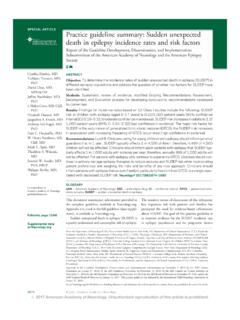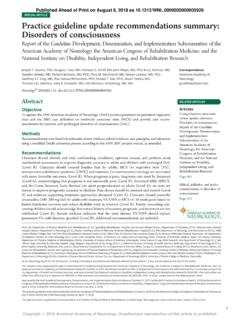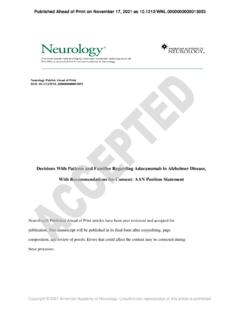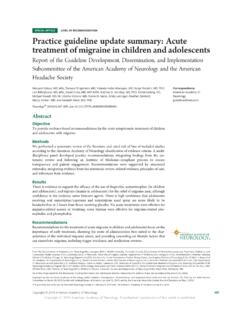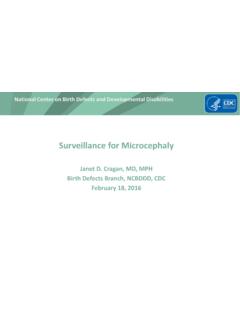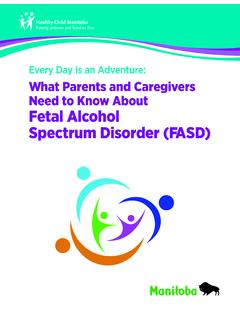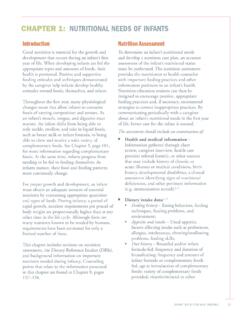Transcription of DSM-5 criteria for ADHD - Neurology
1 Appendix e-1. DSM-5 criteria for ADHD DSM-5 criteria for ADHD People with ADHD show a persistent pattern of inattention and/or hyperactivity-impulsivity that interferes with functioning or development: 1. Inattention: Six or more symptoms of inattention for children up to age 16, or five or more for adolescents 17 and older and adults; symptoms of inattention have been present for at least 6 months, and they are inappropriate for developmental level: Often fails to give close attention to details or makes careless mistakes in schoolwork, at work, or with other activities. Often has trouble holding attention on tasks or play activities. Often does not seem to listen when spoken to directly.
2 Often does not follow through on instructions and fails to finish schoolwork, chores, or duties in the workplace ( , loses focus, side-tracked). Often has trouble organizing tasks and activities. Often avoids, dislikes, or is reluctant to do tasks that require mental effort over a long period of time (such as schoolwork or homework). Often loses things necessary for tasks and activities ( school materials, pencils, books, tools, wallets, keys, paperwork, eyeglasses, mobile telephones). Is often easily distracted Is often forgetful in daily activities. 2. Hyperactivity and Impulsivity: Six or more symptoms of hyperactivity-impulsivity for children up to age 16, or five or more for adolescents 17 and older and adults; symptoms of hyperactivity-impulsivity have been present for at least 6 months to an extent that is disruptive and inappropriate for the person s developmental level: Often fidgets with or taps hands or feet, or squirms in seat.
3 Often leaves seat in situations when remaining seated is expected. Often runs about or climbs in situations where it is not appropriate (adolescents or adults may be limited to feeling restless). Often unable to play or take part in leisure activities quietly. Is often "on the go" acting as if "driven by a motor". Often talks excessively. Often blurts out an answer before a question has been completed. Often has trouble waiting his/her turn. Often interrupts or intrudes on others ( , butts into conversations or games) In addition, the following conditions must be met: Several inattentive or hyperactive-impulsive symptoms were present before age 12 years. Several symptoms are present in two or more setting, ( , at home, school or work; with friends or relatives; in other activities).
4 There is clear evidence that the symptoms interfere with, or reduce the quality of, social, school, or work functioning. The symptoms do not happen only during the course of schizophrenia or another psychotic disorder. The symptoms are not better explained by another mental disorder ( Mood Disorder, Anxiety Disorder, Dissociative Disorder, or a Personality Disorder). Based on the types of symptoms, three kinds (presentations) of ADHD can occur: Combined Presentation: if enough symptoms of both criteria inattention and hyperactivity-impulsivity were present for the past 6 months Predominantly Inattentive Presentation: if enough symptoms of inattention, but not hyperactivity-impulsivity, were present for the past six months Predominantly Hyperactive-Impulsive Presentation: if enough symptoms of hyperactivity-impulsivity but not inattention were present for the past six months.
5 Because symptoms can change over time, the presentation may change over time as well. Reference: Division of Human Development, National Center on Birth Defects and developmental Disabilities, Centers for Disease Control and Prevention Attention-Deficit/Hyperactivity Disorder Web page. Updated September 29, 2014. Accessed November 20, 2014. Appendix e-2. AAN GDDI mission The mission of the GDDI is to develop, disseminate, and implement evidence-based systematic reviews and clinical practice guidelines related to the causation, diagnosis, treatment, and prognosis of neurologic disorders. The GDDI is committed to using the most rigorous methods available within its budget, in collaboration with other available AAN resources, to most efficiently accomplish this mission.
6 Appendix e-3. AAN GDDI members 2014 2015 The AAN has structured its subcommittee overseeing guideline development in several ways in recent years. The GDDI was first formed in 2014; it existed under a previous name and structure when this practice advisory project was inaugurated. At the time this advisory was approved to advance beyond subcommittee development, the subcommittee was constituted as below. Cynthia Harden, MD (Chair); Steven R. Mess , MD (Co-Vice-Chair); Sonja Potrebic, MD, PhD (Co-Vice-Chair); Eric J. Ashman, MD; Richard L. Barbano, MD, PhD; Brian Callaghan, MD; Jane Chan, MD; Diane Donley, MD; Richard M. Dubinsky, MD, MPH; Terry Fife, MD; Jeffrey Fletcher, MD; Michael Haboubi, DO; John J.
7 Halperin, MD; Yolanda Holler, MD; Andres M. Kanner, MD; Annette M. Langer-Gould, MD, PhD; Jason Lazarou, MD; Nicole Licking, DO; David Michelson, MD; Pushpa Narayanaswami, MBBS, DM; Maryam Oskoui, MD; Richard Popwell, Jr., MD; Tamara Pringsheim, MD; Alejandro A. Rabinstein, MD; Alexander Rae-Grant, MD; Anant Shenoy, MD; Kevin Sheth, MD; Kelly Sullivan, PhD; Theresa A. Zesiewicz, MD; Jonathan P. Hosey, MD (Ex-Officio); Stephen Ashwal, MD (Ex-Officio); Deborah Hirtz, MD; Jacqueline French, MD (Guideline Process Historian) Appendix e-4. Complete search strategy Medline, EMBASE, and Central databases, without time constraints 1. ADHD 2. Attention$ 3. Attention Deficit Hyperactivity Dis$ 4.
8 ADD 5. Attention Deficit Dis$ 6. 1 OR 2 OR 3 OR 4 OR 5 7. EEG 8. theta 9. beta 10. beta/theta 11. 8 OR 9 OR 10 10. 6 AND 7 AND 11 Appendix e-5. AAN rules for classification of evidence for risk of bias Diagnostic scheme Class I A cohort study with prospective data collection of a broad spectrum of persons with the suspected condition, using an acceptable reference standard for case definition. The diagnostic test is objective or performed and interpreted without knowledge of the patient s clinical status. Study results allow calculation of measures of diagnostic accuracy. Class II A case-control study of a broad spectrum of persons with the condition established by an acceptable reference standard compared to a broad spectrum of controls or a cohort study where a broad spectrum of persons with the suspected condition where the data was collected retrospectively.
9 The diagnostic test is objective or performed and interpreted without knowledge of disease status. Study results allow calculation of measures of diagnostic accuracy. Class III A case-control study or cohort study where either persons with the condition or controls are of a narrow spectrum. The condition is established by an acceptable reference standard. The reference standard and diagnostic test are objective or performed and interpreted by different observers. Study results allow calculation of measures of diagnostic accuracy. Class IV Studies not meeting Class I, II, or III criteria , including consensus, expert opinion, or a case report. Appendix e-6. Modified GRADE criteria applied to clinical questions Modified GRADE criteria applied to question 1* Diagnostic test Outcome No.
10 & class of studies Effect Precision Consistency Directness Plausibility Publication bias Magnitude of effect Dose response Comment Confidence in evidence EEG theta/beta ratio and EEG frontal power Improved diagnosis 1 Class III Accuracy 88% (95% CI 84% 91%) D The examination used in the trial would rarely be available to the clinician Very low Abbreviation: CI = confidence interval *For patients with attention-deficit/hyperactivity disorder (ADHD) [patient population], does the addition of EEG theta/beta ratio and EEG frontal power [diagnostic test], compared with standard clinical diagnosis [comparative intervention], lead to improved diagnosis of ADHD [outcome]? Includes benefits to core symptoms and associated conditions, harms, tolerability.
